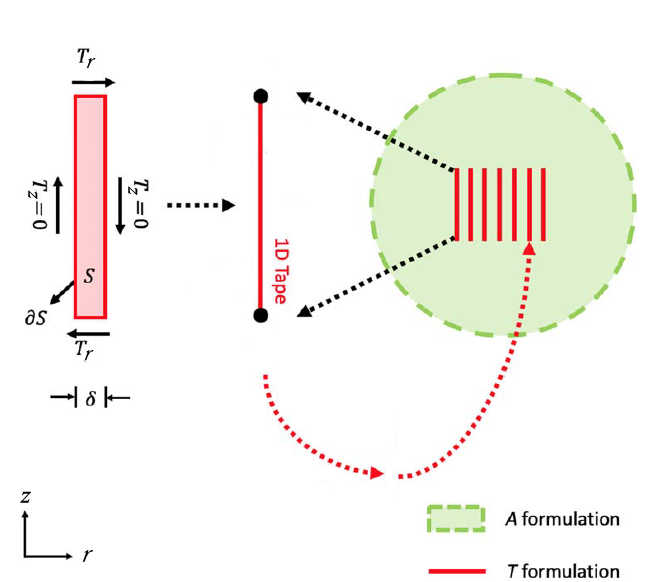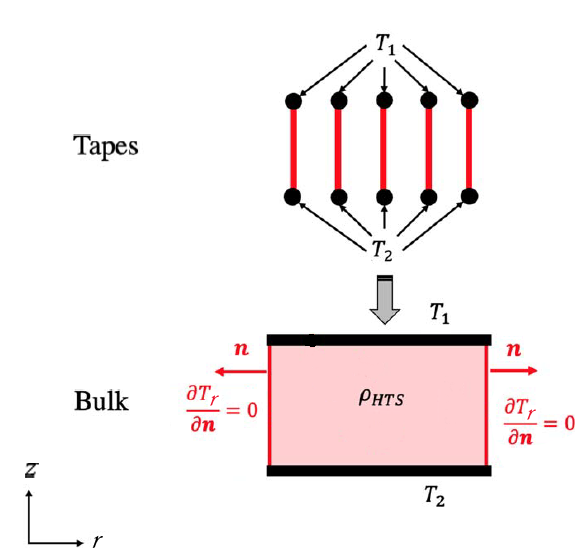Axisymmetrical Case
1. T-A Formulation
2. Differential Formulation
In this section, we will express the T-A Formulation on a geometry in axisymmetric coordinates.
We note \(\Omega^{axis}\), \(\Omega^{axis}_c\), \(\Gamma^{axis}\), \(\Gamma_D^{axis}\), \(\Gamma_N^{axis}\) and \(\Gamma_c^{axis}\) the representation of \(\Omega\), \(\Omega_c\), \(\Gamma\), \(\Gamma_D\), \(\Gamma_N\) and \(\Gamma_c\) in axisymmetric coordinates.
We note \(u = \begin{pmatrix} u_r \\ u_{\theta} \\ u_z \end{pmatrix}_{cyl}\) the coordinates of \(u \in \mathbb{R}^3\) in cylindrical base.
We note \(\mathbf{n}^{axis} = \begin{pmatrix} n^{axis}_r \\ n^{axis}_z \end{pmatrix}_{cyl}\) the exterior normal of \(\Gamma^{axis}\) on \(\Omega^{axis}\).
First, for the A-formulation we will use the same changes as in the Atheta Axisymmetric case. We have \(\mathbf{B} = \begin{pmatrix} B_r(r,z) \\ 0 \\ B_z(r,z) \end{pmatrix}_{cyl}\) and \(\mathbf{A}= \begin{pmatrix} 0 \\ A_{\theta}(r,z) \\ 0 \end{pmatrix}_{cyl}\) and :
On the other hand, due to the aspect ratio between the height and the width of the coated conductor, the T-A formulation uses a thin strip approximation of the tapes, reducing the superconducting domain to a thin sheet.

The current is restricted to flow within this sheet, and \(T\) is reduced to the component perpendicular to the tape. In axisymmetrical coordinates, the HTS tape is reduced to a 1D vertical line element and \(J=\nabla\times T\) becomes :
Then when using the faraday law to have the T-formulation, the equation can be reduced to :
We can replace \(E_\theta\) using \(E=\rho J\) and \(B_r\) with \(-\frac{\partial A_\theta}{\partial z}\) :
As \(T = \begin{pmatrix} T_r(r,z) \\ 0 \\ 0 \end{pmatrix}_{cyl}\), we have \(\frac{\partial \rho J_\theta}{\partial z} =\rho \frac{\partial^2 T}{\partial z^2}\) and the equation becomes :
We replace \(J\) in the A-formulation by \(\frac{\partial T_r}{\partial z}\).
To conclude, the T-A Formulation becomes :
With \(\Delta A_\theta = \frac{\partial^2 A_\theta}{\partial z^2} + \frac{1}{r} \frac{\partial \left( r \frac{\partial A_\theta}{\partial r} \right)}{\partial r} \)
2.1. Transport Current
The boundary conditions at the edge of the 1D superconducting layer for \(T\) can be obtained by integrating the current density \(J\) over the cross-section of the layer which is equal to the transport current in the tape :
As the component of \(T\) parallel to the layer is zero, \(I\) becomes :
with \(\delta\) being the thickness of the superconducting tape and \(T_1\) and \(T_2\), the potentials at the extremities of the 1D layer.
Therefore, by modifying \(T_1\) and \(T_2\), we can express the transport current.
3. Weak Formulation
The weak formulation of equation (TA Axis) in two dimensions can be expressed as follows :
We multiply the equation (A Axis) by \(\phi \in H^1(\Omega)\) and integrate it on \(\Omega\) :
By Formula of Green :
We switch to axisymmetrical coordinates :
With \(\tilde{\nabla} = \begin{pmatrix} \partial_r \\ \partial_{\theta} \\ \partial_z \end{pmatrix}_{cyl}\)
We impose the boundary conditions :
-
Dirichlet : \(A_{\theta} = 0\) on \(\Gamma_D^{axis}\) (D Axis)
-
Neumann : \(\frac{\partial A_{\theta}}{\partial n} = 0\) on \(\Gamma_N^{axis}\) (N Axis)
So, the weak formulation is :
Then we multiply the equation (T Axis) by \(\varphi \in H^1(\Omega_c)\) and integrate it on \(\Omega_c\) :
By Formula of Green :
We switch to axisymmetrical coordinates :
With \(\tilde{\nabla} = \begin{pmatrix} \partial_r \\ \partial_{\theta} \\ \partial_z \end{pmatrix}_{cyl}\)
We impose the boundary conditions :
-
Dirichlet : \(T_r = 0\) on \(\Gamma_D^{axis}\) (D Axis)
-
Neumann : \(\frac{\partial T_r}{\partial n} = 0\) on \(\Gamma_N^{axis}\) (N Axis)
So, the weak formulation is :
Finally we have :
4. Time Discretization
In this subsection, we use the time discretization by backward Euler method on the (Weak T-A Axi).
We discretize in time the problem with the time step \(\Delta t\).
We note \(f^n(\mathbf{x}) = f(n\Delta t, \mathbf{x})\), for \(n \in \mathbb{N}\).
We have the approximation with backward Euler method : \(\frac{\partial (\partial_z A_\theta)}{\partial t} \approx \frac{(\partial_z A_\theta)^{n+1}-(\partial_z A_\theta)^n}{\Delta t}\).
The equations (Weak A Axi) becomes :
5. Homogeneous Axisymmetrical Case
The homogenization technique is modeling a stack of HTS tapes as a homogeneous anisotropic bulk.

The bulk represent a densely packed stack of 1D superconducting layers. The A-formulation is defined on the entire domain , but the T-formulation is only defined on the superconducting material.
5.1. Differential Formulation
In this section, we will express the T-A Formulation on a geometry in homogeneous axisymetric coordinates.
First, for the A-formulation, we will use a scaled current density approximation :
where \(\delta\) is the thickness of a tape, \(\Lambda\) the space between two tapes and \(J_\theta = \partial T_r/\partial z\).
The A-formulation becomes :
On the other hand, the T-formulation is unaffected by the homogeneous method :
The T-A Formulation becomes :
With \(\Delta A_\theta = \frac{\partial^2 A_\theta}{\partial z^2} + \frac{1}{r} \frac{\partial \left( r \frac{\partial A_\theta}{\partial r} \right)}{\partial r} \)
5.2. Transport Current
The boundary conditions at the edge of the 1D superconducting layer for \(T\) are still obtained by integrating the current density \(J\) over the cross-section of the layer which is equal to the transport current in the tape. These boundary conditions are to be appied of the edges of the bulk corresponding to the extremities of the tapes. Additionally, the boundary conditions on the side edges of the bulk are Neumann boundary conditions :
5.3. Weak Formulation
The weak formulation of equation (TA Axis) in axisymmetric coordinates can be expressed as follows :
5.4. Time Discretization
In this subsection, we use the time discretization by backward Euler method on the (Weak T-A Axi).
We discretize in time the problem with the time step \(\Delta t\).
We note \(f^n(\mathbf{x}) = f(n\Delta t, \mathbf{x})\), for \(n \in \mathbb{N}\).
We have the approximation with backward Euler method : \(\frac{\partial (\partial_z A_\theta)}{\partial t} \approx \frac{\partial_z A_\theta^{n+1}-\partial_z A_\theta^n}{\Delta t}\).
The equations (Weak A Axi) becomes :
6. References
-
Real-time simulation of large-scale HTS systems: multi-scale and homogeneous models using the T–A formulation, Edgar Berrospe-Juarez et al 2019 Supercond. Sci. Technol. 32 065003, PDF